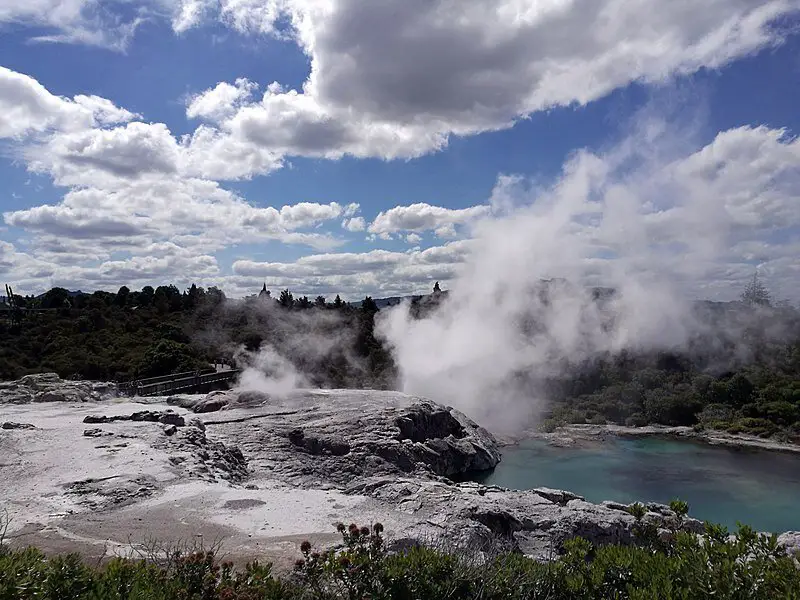5 Causes of Thermal Pollution and Their Impacts Explained
Causes of thermal pollution are; deforestation, soil erosion, urban stormwater runoff, geothermal fluid dynamics and unsustainable industrial discharge.
This article discusses the causes of thermal pollution, as follows;
1). Deforestation (as one of the Causes of Thermal Pollution)
One of the potential causes of thermal pollution is deforestation.
Deforestation leads to thermal pollution of soil and water by causing the loss of vegetation which previously served as shade to these media.
The role of deforestation in thermal pollution is a secondary, supportive role which it usually shares with solar radiation.
Rather than act as a direct cause, deforestation increases the possibility of thermal pollution. When the protection from sunlight provided by trees and other plants, is lost to deforestation; there is increased exposure, meaning that a previously shaded medium or environment becomes more vulnerable to the agents of thermal pollution, which may then have more-pronounced impact on the medium or environmental system.
As the name implies, deforestation is most likely to cause thermal pollution in forested areas (that is; forest ecosystems), and has a high tendency to affect aquatic ecosystems in such locations.
This is due to the fact that vegetation is abundant and forms a significantly-dense cover/canopy over soil and water in forests, and water itself has good conductive properties that enable it absorb immense quantities of thermal energy from the Sun, at a relatively-rapid rate.
Some effects of thermal pollution induced by deforestation and solar exposure include; increased toxin concentration and decline in species richness/biodiversity.
In addition to increasing exposure to heat, deforestation affects the carbon cycle in any ecologic zone where it occurs, by reducing the capacity of the natural vegetative carbon sink to contribute to important processes like carbon sequestration; as well as by reducing the rate with which biomass is produced and consumed in the food chain and biomass pyramid of a given ecosystem.
2). Soil Erosion
In both urban and non-urban areas, soil erosion is one of the factors that can cause thermal pollution.
Soil erosion causes thermal pollution through diverse means, one of which is increased exposure.
In water catchment areas, the elevation of the water surface relative to the ground affects the amount of thermal radiation from both solar and manmade sources, that is captured and absorbed by the water.
With soil erosion, water elevation in such catchments tends to increase relative to the ground-level, so that water bodies become more exposed to thermal radiation.
Another mechanism by which soil erosion causes thermal pollution is sedimentary heat-absorption. Runoff produced in the course of soil erosion usually contains sediments which are transported and deposited in water bodies. These sedimentary materials have heat capacities of their own, which differ from the heat capacity of water.
Being impurities, the sediments increase the overall heat absorption/retention capacity of aquatic systems in which they occur, including marine water bodies, lakes and ponds, and artificial water-collection reservoirs. This is especially effective for sedimentary materials that are in suspension within a water column (such as muddy sediments).
The presence of such materials derived from soil erosion increases the temperature of water bodies due to their own heat-retention that combines with that of water.
Suspended sediments from soil erosion, can also increase the scale and effectiveness of anaerobic processes in water, which in turn raise the temperature. This is possible because sediments in suspension can cause the water column to be stratified, so that dissolved oxygen becomes confined to certain levels, depths or zones, while other zones become oxygen-deficient.
Such a phenomenon is self-sustaining and highly effective at causing further thermal pollution, because oxygen depletion is both a potential cause and an effect, of thermal pollution.

3). Urban Stormwater Runoff (as one of the Causes of Thermal Pollution)
Stormwater is the term used to describe significant volumes of water that form aa a result of precipitation events like rainfall.
The additional word; 'runoff' is adjectival, and signifies that the water is in a mobile, flowing state.
Urban areas are particularly prone to major stormwater runoff events because they offer less permeable ground and/or natural reservoirs for water conservation or absorption after heavy rainfalls, than natural ecosystems like forests and grasslands.
Concrete-covered grounds in urban areas facilitate large-scale formation of stormwater, which in many cases leads to flooding.
The impact of stormwater runoff as an agent of pollution depends on the composition of the stormwater itself, which becomes toxic as a result of a process called stormwater pollution.
Stormwater pollution results from the introduction of foreign materials into water as it flows across a given area. These foreign materials could include sediments, gases, and industrial chemicals among others.
Thermal pollution by stormwater runoff occurs when the stormwater flows into water bodies or reservoirs, thereby introducing sediments, organic and inorganic materials, and chemicals, into these systems [2].
The outcome can be very hazardous, and often features acute water pollution that may take several forms including microbial pollution with domestic waste from sewage management systems and landfills, and plastic pollution with inorganic, insoluble materials.
These different forms of degradation can lead to major changes in temperature of the polluted medium, due to chemical and biological processes like redox reactions and biodegradation, that occur among the impurities.
Some common pollutants in urban stormwater runoff are; microbes, sewage, non-biodegradable materials like plastics, chemicals like pesticide, and refined energy resources like gasoline.
Aside the influence of inorganic and organic pollutants, thermal pollution by stormwater runoff can also occur due to the absorption of heat by flowing stormwater.
Runoff from paved surfaces in urban areas causes thermal pollution through conductive energy-transfer, whereby heat from the paved surface raises the temperature of stormwater that comes in contact with it, and is subsequently conveyed by the now-heated stormwater into cooler water bodies or soils.
When urban stormwater causes thermal pollution in nearby water bodies, the effects could include decrease in dissolved oxygen, impeded reproduction and survival of local aquatic organisms [5].
Some studies suggest that methods like bioremediation can be used to reverse these effects [4].
4). Geothermal Fluid Dynamics
Geothermal energy is a form of renewable energy that occurs in the form of heat mostly from nuclear materials and reactions in the Earth's core [1]. It is often stored and conveyed in hot, mineralized water from the subsurface, known as geothermal fluid.
Thermal pollution by geothermal fluid occurs when hot fluid from geothermal reservoirs is introduced into colder water bodies. This can occur in the form of wastewater disposal from geothermal power plants, or by geothermal intrusion of shallow aquifers containing groundwater.
Geothermal fluid dynamics is one of the only natural, potential causes of thermal pollution, and may cause degradation in very rare cases, with much-less severity than manmade causes.
Other natural causes of thermal pollution are; volcanoes and wildfires.

5). Unsustainable Industrial Discharge (as one of the Causes of Thermal Pollution)
The industrial causes of thermal pollution are mainly discharged materials like wastewater from manufacturing facilities and power plants.
These materials may include water that is used as coolant for engines and turbines used in electricity generation, or waste from the processing of raw materials and the manufacture of products.
Industrial discharge is one of the most common and potent causes of thermal pollution in many parts of the world.
Conclusion
Causes of thermal pollution are;
1. Deforestation
2. Soil Erosion
3. Urban Stormwater Runoff
4. Geothermal Fluid Dynamics
5. Unsustainable Industrial Discharge
References
1). Hamm, S.; Metcalfe, E. (2019). "Harnessing the Heat Beneath Our Feet: Geothermal Energy." Available at: https://kids.frontiersin.org/articles/10.3389/frym.2019.00105. (Accessed 17 May 2023).
2). Herb, W. R.; Janke, B.; Mohseni, O.; Stefan, H. G. (2008). "Thermal Pollution of Streams by 3)
3). Runoff From Paved Surfaces." Hydrological Processes 22(7):987 - 999. Available at: https://doi.org/10.1002/hyp.6986. (Accessed 17 May 2023).
4). Li, J.; Li, J.; Li, X.; Li, Z. (2022). "Analysis of Thermal Pollution Reduction Efficiency of Bioretention in Stormwater Runoff under Different Rainfall Conditions." Water 2022, 14, 3546. Available at: https://doi.org/10.3390/w14213546. (Accessed 17 May 2023).
5). Simpson, M.; Winston, R. J. (2022). "Effects of land use on thermal enrichment of urban stormwater and potential mitigation of runoff temperature by watershed-scale stormwater control measures." Elsevier, Ecological Engineering, Volume 184, November 2022, 106792. Available at: https://doi.org/10.1016/j.ecoleng.2022.106792. (Accessed 17 May 2023).




